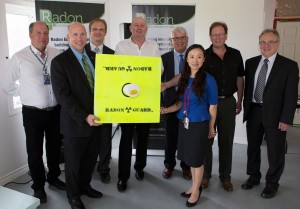 As awareness about the dangers associated with radon grow so will innovation in the construction industry to protect against it – and that’s a good thing. Radon resistant construction is used when new homes and buildings are built, however it’s still possible for radon to seep into any home – even those specifically designed to keep it out.
As awareness about the dangers associated with radon grow so will innovation in the construction industry to protect against it – and that’s a good thing. Radon resistant construction is used when new homes and buildings are built, however it’s still possible for radon to seep into any home – even those specifically designed to keep it out.
On June 17th, 2014 at the National Research Council of Canada (NRCC) in Ottawa an event was held to celebrate the launch of Radon Guard. Radon Guard is a structural under-slab ventilation system that creates a capillary break between the ground and air barrier equipment. In layman’s terms, that means it helps ventilate gas that builds up underneath a home after seeping through the soil. In that respect, it lowers the concentration of radon in the home – helping to maintain clean air inside.
The Canadian Construction Materials Centre (CCMC) has certified Radon Guard as National Building Code 2010 compliant. Since radon resistant features are a code requirement for new construction including homes, schools and even commercial buildings, Radon Guard will certainly be useful.
Alan Whitehead, President and CEO of Radon Environmental Management believes that Radon Guard will save lives.
“Radon Guard will become the gold standard for sub-slab ventilation systems in new construction and will save thousands of lives.”
Randi Fox, the principal of Fox Architecture and founder of Radon Guard, believes much the same thing and that’s exactly why he created the system.
“Radon Guard provides many advantages over the use of the code prescriptive gravel, which can be regionally hard to find, expensive to transport and labour intensive to install. It is also a potential source of radon itself. Radon Guard will soon be readily available at most building suppliers, is competitively priced, and is fast clean and easy to install. It is a cost effective and efficient insulated under-slab ventilation system.”
Now that the technology has been certified, it would be nice to see it used elsewhere in the world such as here in the United States. Still, it’s a great leap in innovation in terms of radon resistant construction.
After all, Radon is the second leading cause of lung cancer in many countries including the US and Canada. Health Canada has estimated that more than 3,200 Canadians die each year due to radon-induced lung cancer. This is because lung cancer has a remarkably high mortality rate, as it’s often diagnosed in its later stages. Symptoms of lung cancer don’t begin to show until the late stages where patients have neared an incurable state. Worse yet, those who smoke or have been exposed to tobacco smoke have an increased risk of contracting lung cancer if they are also exposed to elevated levels of radon.
Radon resistant construction and related technology is extremely important. It’s good to see new players in the market.
Via: Digital Journal


